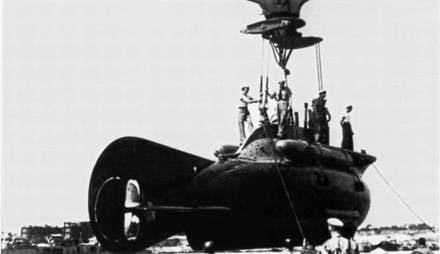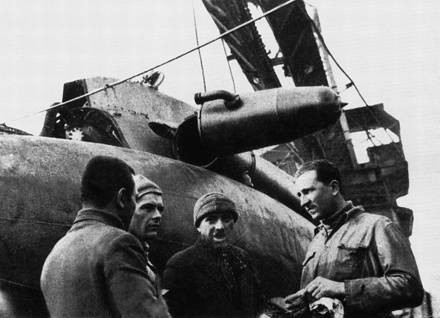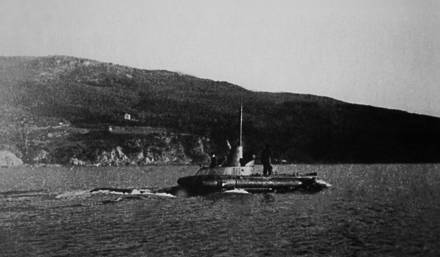Found a braid on the stone

Design features
Ultra-small submarines of type SV were the most numerous representatives of this class in the Italian Navy during the Second World War - a total of 1943 was built and transferred the fleet 22 submarines of this type. And this despite the fact that initially this submarine was a purely commercial project of the company Kaproni and only after successful tests ordered by the Italian admirals, was adopted.
The main power plant SMPL type SV - diesel-electric. It consisted of a diesel company "Isotta Fraschini" power shaft 80 l. with. and an eletromotor of the Brown-Boveri company with a shaft power of 50 l. with. The propeller is one propeller.
The submarine had a light and durable hull and outwardly markedly different from the Italian SMPL other types. Basically - the presence of a kind of small superstructure and low cutting conical shape, which allowed crew members to safely be on the upper deck of the submarine during its maneuvering on the surface.
The SM-type SVPL armament was represented by two 450-mm torpedo tubes located outside the submarine’s robust hull. Thus, for reloading torpedo tubes it was not necessary to pull the SMPL out of the water, which greatly facilitated its maintenance compared to ships of a similar class of other types that were at the disposal of the naval forces of fascist Italy.
The construction of the SMPL of the SV type was carried out in two series. The first six submarines (numbers from 1 to 6) were built in Milan by Caproni and transferred to the fleet from January to May of 1941. The construction of the remaining submarines was continued almost two years later, and the SMPLS-7 was transferred to the Italian Navy only on August 1 of the year 1943. In the same year, the construction of the series was completed.
Combat use of SMPL type SV
The fate of ultra-small submarines of the SV type has evolved differently. Some “supermulkings” never had a chance to take part in hostilities in their lifetime. Moreover, the first six submarines took an active part in the hostilities on the Black Sea against the Soviet Navy.
Submarines CB-8, 9, 10, 11 and 12 surrendered to British troops at the Taranto naval base in September 1943.
SMPLSV-7 had a more interesting fate. She was captured by German forces in Pole and then transferred to the Italian Socialist Republic Navy (northern Italy, led by Mussolini and supported by the military forces of the Third Reich). However, after a while, it had to be disassembled for parts to maintain another SMPL, SV-13, in combat readiness. However, this did not really help the latter, and along with SMPLSV-14, 15 and 17, it was destroyed during aviation Allied raids during 1945.
SMPLSV-16 was also transferred to the Navy of the last Italian Republic, headed by Mussolini. October 1 1944, she "lay on the ground," as written in foreign sources (for whatever reason - it is not clear, but most likely was just thrown), in the immediate vicinity of Senegal on the Adriatic coast of the Mediterranean and was subsequently seized by the British.
CB-18 and 19 at the time of the end of hostilities were in Venice and were cut into metal shortly after the end of World War II.
The fate of SMPL SV-20, which was captured by the Yugoslav partisans in Pole, is mysterious, and story unknown until now. It is likely that it was transferred to the then ally of Marshal Tito - the Soviet Union.
SMPL CB-21 was rammed on and sunk by a German high-speed ferry during its transfer by sea to Ancona in order to surrender to the allies.
Finally, the last SMPL NE-22 was captured by the Allied forces at the very end of the war in Trieste. Then for several long years, up to the year 1950, her hull was lying unattended on the shore near the port. But that year a group of enthusiasts, as we say, restored this SMPL, and now it is put on display to the general public at the Museum of War in the city of Trieste.
Actions on the Soviet-German front
14 January 1942, the admiral of the Italian Navy, Ricardi signed an agreement with his fellow German colleagues, according to which since the spring of 1942, the national Navy of fascist Italy began to be recruited to help the German forces on the Soviet-German front. For the Italians, two areas were identified - Lake Ladoga and the Black Sea theater. In the first case, it was intended to immediately launch 4 boats from the 10 fleet of the MAS flotilla under the command of captain 3 of Bianchini to Ladoga, and 10 boats of the MAS type, 5 type of torpedo boats of the MTVM, 5 type assault boats and assault boats were sent to the Black Sea. - from the 10 fleet of the MAS) and the squadron of the 6 SMPL type SV (for the numbers 1 – 6). The latter were loaded onto railway platforms and, under the strictest secrecy, from 25 April to 2 in May 1942 were transferred from the permanently-based area to La Spezia to Constanza (Romania), where they were launched and alerted.
Then, by sea, they moved to the Crimea, where the Yalta port was chosen as a base. The first group of three SMPL arrived in Yalta 5 May 1942. These were CB-1 (commander - lieutenant commander Lezen d'Asten), CB-2 (commander - junior lieutenant Attilio Russo) and CB-3 (commander - second lieutenant Giovanni Sorrentino). On June 11, the second group of SMPLs of SV-4 (commander - second lieutenant Armando Sebile), SV-5 (commander - lieutenant commander Faroroli) and SV-6 (commander - lieutenant Galliano) arrived in Yalta. All six submarines were placed in the inner bucket of the port and carefully disguised, which did not prevent the Soviet motorists from sinking one of them.

SMPL CB-1 and its crew. The starboard torpedo tube is open, either for reloading or for technical inspection. Constanta, Romania
After the attack of the Soviet torpedo boats D-3 and SM-3 under the general command of K. Kochiev, as a result of which SMPL CB-5 went to the bottom together with its commander, lieutenant commander Faroroli, only five Italian SMPLs of St. type were left in the Crimea. They accepted quite active participation in the violation of communications of the Soviet Black Sea Fleet and reliably sank the Kambala U-S 203 submarine (V-bis, commander - captain 3 rank Vladimir Innokentievich Nemchinov). This occurred presumably on the night of August 26 1943, in the area of Cape Uret at the point 45 deg. 11 min. 7 seconds with. sh. and 32 hail. 46 min. 6 seconds at. d. (August submarine 20 entered the area of Cape Tarkhankut on the position number 82). The entire team as a member of 46 perished. In the 1950, this submarine was raised (the survey found that the boat had no torpedoes in TA number 1 and 4).
The Italian SMPL CB-4 has become the killer of the Soviet submarine. According to the report of its commander, SV 4 was in the surface position, when 26 August 1943 of the year in 400 meters, the commander Armando Sebilla himself discovered a surfaced Soviet submarine. The latter, having started a diesel engine, started moving towards the Italian SMPL, not noticing it. SV-4 stalled the course, and W-203 passed from it approximately in 50 – 60 meters, and on the bridge of the Soviet submarine the Italian commander even managed to see a man peering into the distance. Left behind the stern at Š-203, the Italian SMPL carried out the circulation and occupied a favorable position for torpedo firing. Then, from a distance of about 800 meters, Sebilele performed torpedo firing with one torpedo, which unexpectedly leaned to the left and did not harm the Soviet submarine. A second torpedo was fired right there, which reached the target in 40 seconds, hitting before landing M-203. A high water column shot up, a strong explosion was heard, and after a few moments the Soviet submarine disappeared under water.
According to Italian data, the ultra-small submarines sank and another Soviet submarine - C-32. However, this information is not confirmed by domestic sources. Moreover, some foreign books provide even more incorrect information - ostensibly SMPL-type SV on the Black Sea sank the Soviet submarine U-207 and U-208 (in particular: Paul Kemp. Midget submarines of the Second World War. Caxton Editions. 2003). It is completely incomprehensible where such information could have come from. It is immediately evident that the author did not even bother to get acquainted with our, Russian, literature on the subject.
For example, Paul Kemp claims that the SV-2 18 of June 1942 of the year attacked and drowned the U-208 submarine, and the SMPL-UE-4 25 of August 1943 sub-Tarahankuta sunk the Soviet U-207 submarine. By the way, it is also stated there that the SV-5 was sunk in the port of Yalta not by torpedo boats, but by torpedo-carrying aircraft. Quite an interesting assumption, giving weight to our torpedo pilots, but completely unfounded.
With the "sunk" the Soviet submarines, the situation is even more absurd. The fact is that the submarine UH-207 (V-bis, second series) could not have been sunk during the war, because ... it successfully completed and was expelled from the USSR Navy's military personnel only on July 16 1957 of the year due to the transfer of the submarine to the special polygon Air Force Navy in the Caspian Sea for use as a target! So CB-4 actually sank the Soviet submarine U-203, which is reliably confirmed by our sources.
The situation with the submarine Shch-208 (X series, the commander of Lieutenant Commander N. M. Belanov) is somewhat more complicated, since she really went missing during a military hike in the Portitsky district of the Danube river from August 23 to September 8. However, the majority of Russian and foreign sources nevertheless agree that the most likely cause of her death is an explosion on the mines of the Romanian barriers or an explosion on a floating mine.
The fact of sinking of the Soviet C-32 submarine (IX-bis series, commander of 3 rank captain Pavlenko Stefan Klimentevich) by the Italian ultra-small submarine of the SV type is confirmed by both Italian and Russian sources. In the latter case, see: A. V. Platonov. Soviet warships 1941 – 1945 Part III. Submarines. St. Petersburg. 1996 78 – 79. The author claims that C-32 was sunk by the Italian SMPLSV-3 26 on June 1942, during the first regular flight on the Novorossiysk-Sevastopol route. Place drowning - Cape Aitodor area.
On the other hand, some foreign sources mention that the C-32 was sunk by 26 on June 1942 by a bomber of the Non-111 type from the 2 / KG 100 battle group. There is also a version that the submarine could have caused an explosion of the cargo it transported to Sevastopol - 40 tons of ammunition and 30 tons of gasoline. Although the information that the remains of the C-32 submarine hull were recently found at the bottom of the Black Sea south-west of Yalta, speaks in favor of the version about the sinking of its Italian SMPL.

Italian SMPL type CB is on the surface above the Crimean coast. Summer 1942 of the year
In total, during the stay in Russia, the Italian SMPL made 42 combat campaigns, losing only one boat at sea (according to Italian data, it was lost not in battle, but for another reason).
October 9 1942 of the Italian Navy 4 Flotilla, which included all the SMPL and combat boats on the Black Sea (the fleet commander captain 1 of the rank of Mimbelli), received an order to redeploy to the Caspian Sea (!). However, the Soviet troops thwarted these plans 6-I German army at Stalingrad was surrounded and quickly destroyed.
As a result, 2 January 1943, the admiral Bartholdi ordered the recall of all Italian ships from the Black Sea theater of military operations. All the remaining SMPLs of the SV type 9 on September 1943 arrived in Constanta and were transferred to the Romanian Navy. Crews returned to their homeland.
Subsequently, they were captured by the Soviet troops intact and intact, and according to some data, were in service in the Navy of the Soviet Union until the 1955 year.
Information